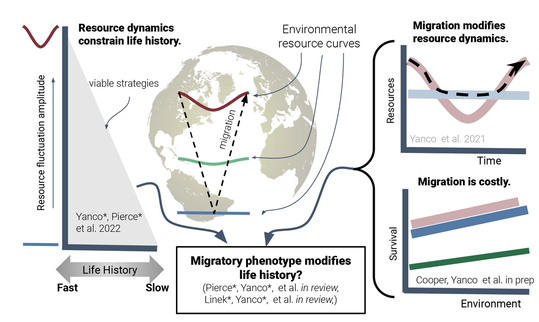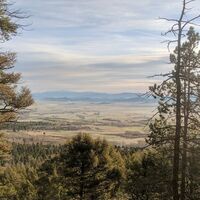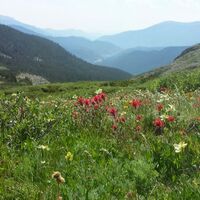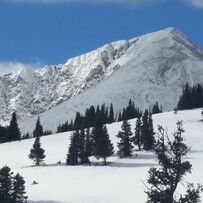Understanding the nexus between environment, life history, and behavior
Life history, environment, and behavior intersect as a complex system of tradeoffs and feedbacks by which individual organisms generate evolutionary fitness. My research seeks a mechanistic understanding of these interwoven processes, particularly in vagile species. In my previous work tracking Flammulated Owl migrations, I demonstrated that migration modulates resource dynamics, revealing eco-evolutionary drivers of seasonal migration. Building on this, my collaborators and I paired theoretical models of individual metabolic dynamics with macro-ecological approaches, finding that realized seasonal resource dynamics constrain the set of viable life histories, producing a global latitudinal gradient. We recently extended this work to consider how migratory phenotype interacts with seasonal resource dynamics. Finally, in collaboration with researchers at the Max Planck Institute of Animal Behavior, I am exploring how metabolic dynamics vary across migratory strategies using body temperature and heart rate data collected from free-living Eurasian Blackbirds.
Life history, environment, and behavior intersect as a complex system of tradeoffs and feedbacks by which individual organisms generate evolutionary fitness. My research seeks a mechanistic understanding of these interwoven processes, particularly in vagile species. In my previous work tracking Flammulated Owl migrations, I demonstrated that migration modulates resource dynamics, revealing eco-evolutionary drivers of seasonal migration. Building on this, my collaborators and I paired theoretical models of individual metabolic dynamics with macro-ecological approaches, finding that realized seasonal resource dynamics constrain the set of viable life histories, producing a global latitudinal gradient. We recently extended this work to consider how migratory phenotype interacts with seasonal resource dynamics. Finally, in collaboration with researchers at the Max Planck Institute of Animal Behavior, I am exploring how metabolic dynamics vary across migratory strategies using body temperature and heart rate data collected from free-living Eurasian Blackbirds.
More Than Movement: Indivdiual Data to Understand the Mechanisms Affecting Populations
Global losses of biodiversity and climate change compel ecologists to seek understanding of the mechanistic basis for anthropogenic impacts on both individual animals and population trajectories. Yet, for many species we lack even basic understanding of the drivers of population trajectories, largely because, until very recently, we could not generate the requisite high-resolution individual data, especially for vagile species. I am leading the development of tools and theory needed to reveal the drivers of population trajectories, through active engagement in several projects that use animal tracking data to estimate population vital rates.
Seasonal Survival of Migratory Birds
I developed a novel approach to survival estimation for Kirtland’s Warblers and found that poor environmental conditions (associated with drier winters in the Caribbean) reduced survival during the following spring migration and summer breeding seasons. This work is the first to directly estimate season-specific survival in a small-bodied migrant - a pressing need given the observed ~30% decline in overall abundance of North American birds - and highlights the power of animal tracking data to detect lagging effects of environmental change on population vital rates.
Disentangling Effects of Human Actvities
Disentangling the specific effects of different components of human activities and infrastructure presents another challenge that remains relatively unexplored. I am co-leading a project leveraging the COVID-19 lockdowns as a natural experiment to disentangle the ways that human activities modify animal behavior. This continental-scale, multi-species analysis (~12 million observations of ~4,000 individuals, ~30 species) revealed core pathways by which species respond to human activities. Using high-resolution human mobility data derived from mobile devices, we provide the first direct evidence that the presence of humans themselves drives animals to use less space and broaden their environmental niches.
Fitness Consequences of Morphological Change
Climate change is also driving widespread shifts in avian morphology, but the causal basis for and the potential consequences of these shifts remains unclear. In my current position, I am tackling this gap by using nest warming manipulations to explore the effects of climate change-induced developmental plasticity on downstream fitness using automated telemetry arrays at both local and regional scales (coupled to an existing continental scale network)
Global losses of biodiversity and climate change compel ecologists to seek understanding of the mechanistic basis for anthropogenic impacts on both individual animals and population trajectories. Yet, for many species we lack even basic understanding of the drivers of population trajectories, largely because, until very recently, we could not generate the requisite high-resolution individual data, especially for vagile species. I am leading the development of tools and theory needed to reveal the drivers of population trajectories, through active engagement in several projects that use animal tracking data to estimate population vital rates.
Seasonal Survival of Migratory Birds
I developed a novel approach to survival estimation for Kirtland’s Warblers and found that poor environmental conditions (associated with drier winters in the Caribbean) reduced survival during the following spring migration and summer breeding seasons. This work is the first to directly estimate season-specific survival in a small-bodied migrant - a pressing need given the observed ~30% decline in overall abundance of North American birds - and highlights the power of animal tracking data to detect lagging effects of environmental change on population vital rates.
Disentangling Effects of Human Actvities
Disentangling the specific effects of different components of human activities and infrastructure presents another challenge that remains relatively unexplored. I am co-leading a project leveraging the COVID-19 lockdowns as a natural experiment to disentangle the ways that human activities modify animal behavior. This continental-scale, multi-species analysis (~12 million observations of ~4,000 individuals, ~30 species) revealed core pathways by which species respond to human activities. Using high-resolution human mobility data derived from mobile devices, we provide the first direct evidence that the presence of humans themselves drives animals to use less space and broaden their environmental niches.
Fitness Consequences of Morphological Change
Climate change is also driving widespread shifts in avian morphology, but the causal basis for and the potential consequences of these shifts remains unclear. In my current position, I am tackling this gap by using nest warming manipulations to explore the effects of climate change-induced developmental plasticity on downstream fitness using automated telemetry arrays at both local and regional scales (coupled to an existing continental scale network)
Building the Internet of Animals
Even as biologging technology has improved, the full promise of big data in animal ecology has yet to be fully realized while the field works to develop the necessary suite of flexible and scalable devices, methods, and infrastructure. In collaboration with the NASA Internet of Animals project, my work is helping to define and realize the future of animal ecology by developing analytic tools and infrastructure to support key community needs. As part of that project I co-established the NASA Internet of Animals (IoA) working group with collaborators at NASA Jet Propulsion Laboratory. I organized the inaugural working group symposium for the IoA Project which brought together an international group of experts from across academia, federal agencies, and research and conservation NGOs. I also led the development of the “science workflow” underlying the beta version of AnimalLives.org which links movement data from the cutting-edge ICARUS project with remote-sensed environmental variables. Our scalable workflow allows the rapid and customizable environmental annotation of GPS data, flexible modeling of space use, and an interactive display.
Even as biologging technology has improved, the full promise of big data in animal ecology has yet to be fully realized while the field works to develop the necessary suite of flexible and scalable devices, methods, and infrastructure. In collaboration with the NASA Internet of Animals project, my work is helping to define and realize the future of animal ecology by developing analytic tools and infrastructure to support key community needs. As part of that project I co-established the NASA Internet of Animals (IoA) working group with collaborators at NASA Jet Propulsion Laboratory. I organized the inaugural working group symposium for the IoA Project which brought together an international group of experts from across academia, federal agencies, and research and conservation NGOs. I also led the development of the “science workflow” underlying the beta version of AnimalLives.org which links movement data from the cutting-edge ICARUS project with remote-sensed environmental variables. Our scalable workflow allows the rapid and customizable environmental annotation of GPS data, flexible modeling of space use, and an interactive display.
Simulation models and the method of multiple working hypotheses
In 1890 Thomas Chamberlin published an article in Science emploring researchers to consider multiple working hypotheses in any inferential endeavor. Chamberlin contended that doing so strengthened inference and guarded against biased outcomes predicated on a researcher's favored ideas. This article is the single most requested reprint the journal Science ever published. Despite its popularity and the critical message it conveys, most researchers in ecology and evolutionary biology still fail to consider multiple hypotheses. I have developed a framework that seeks to further enable researchers to overcome barriers to considering multiple hypotheses in their work. Specifically, I have shown that simulation modeling during the design phase of research can be a powerful tool to avoid collecting data that cannot be used to provide conclusive support for a given hypothesis (model identifiability). My R package checkyourself provides simple code for basic examples of this process in movement ecology and species distributions.
In 1890 Thomas Chamberlin published an article in Science emploring researchers to consider multiple working hypotheses in any inferential endeavor. Chamberlin contended that doing so strengthened inference and guarded against biased outcomes predicated on a researcher's favored ideas. This article is the single most requested reprint the journal Science ever published. Despite its popularity and the critical message it conveys, most researchers in ecology and evolutionary biology still fail to consider multiple hypotheses. I have developed a framework that seeks to further enable researchers to overcome barriers to considering multiple hypotheses in their work. Specifically, I have shown that simulation modeling during the design phase of research can be a powerful tool to avoid collecting data that cannot be used to provide conclusive support for a given hypothesis (model identifiability). My R package checkyourself provides simple code for basic examples of this process in movement ecology and species distributions.
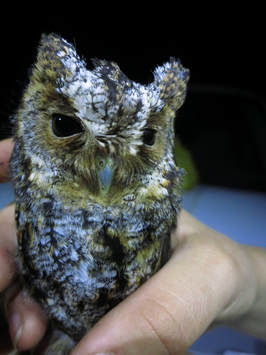
Long-term Research on Flammulated Owls
Soe of my work uses a small migratory owl (Flammulated Owl; Psiloscops flammeolus) as a model system for studying animal movement behavior. I've ben working with this species for over 20 years as part of a project led by Dr. Brian Linkhart at Colorado College dating back to 1981! Long-term data like thia are rare in ecology and have the potential to unique insights into the effects of environmental chaneg on species' behavior and demography.
Changing Fire Regimes
The old-growth forests the species inhabits in North America are highly fire dependent and historically would experience frequent but low severity fires that would “clean out” the underbrush but leave the forest canopy intact. Climate change and recent management practices are moving these fire regimes towards much higher severity fire behavior which results in destructive stand replacing fires which drastically modify the species’ habitat. My work is combining behavioral and demographic datasets to parse the ways that modern fire regimes are affecting this species and montane ecosystems generally.
Migratory Connectivity of a Long-distance Migrant Owl
I am collaborating with the Smithsonian Institute’s Migratory Connectivity Project and several collaborators to better understand the migratory behaviors of Flammulated Owls across the species' range. Generally, our understanding of the biology of migratory populations is limited to the breeding season only, leaving large gaps in our understanding of what is required to maintain healthy populations of many species. (e.g. resource requirements may vary seasonally, species may face survival “bottlenecks” on migration or during winter). We are now tracking these owls year-round with GPS technology to increase our understanding of their full life cycle ecology. We are also combining the direct tracking approaches with intrinsic molecular markers, such as stable isotopes, to reconstruct the breeding-grounds origins of birds captured during the winter (including historical museum speciemens)
Soe of my work uses a small migratory owl (Flammulated Owl; Psiloscops flammeolus) as a model system for studying animal movement behavior. I've ben working with this species for over 20 years as part of a project led by Dr. Brian Linkhart at Colorado College dating back to 1981! Long-term data like thia are rare in ecology and have the potential to unique insights into the effects of environmental chaneg on species' behavior and demography.
Changing Fire Regimes
The old-growth forests the species inhabits in North America are highly fire dependent and historically would experience frequent but low severity fires that would “clean out” the underbrush but leave the forest canopy intact. Climate change and recent management practices are moving these fire regimes towards much higher severity fire behavior which results in destructive stand replacing fires which drastically modify the species’ habitat. My work is combining behavioral and demographic datasets to parse the ways that modern fire regimes are affecting this species and montane ecosystems generally.
Migratory Connectivity of a Long-distance Migrant Owl
I am collaborating with the Smithsonian Institute’s Migratory Connectivity Project and several collaborators to better understand the migratory behaviors of Flammulated Owls across the species' range. Generally, our understanding of the biology of migratory populations is limited to the breeding season only, leaving large gaps in our understanding of what is required to maintain healthy populations of many species. (e.g. resource requirements may vary seasonally, species may face survival “bottlenecks” on migration or during winter). We are now tracking these owls year-round with GPS technology to increase our understanding of their full life cycle ecology. We are also combining the direct tracking approaches with intrinsic molecular markers, such as stable isotopes, to reconstruct the breeding-grounds origins of birds captured during the winter (including historical museum speciemens)
